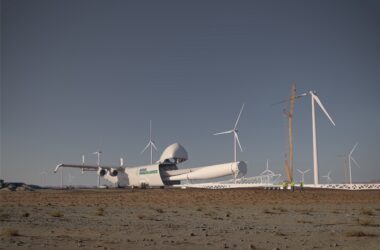In a significant step towards Scotland’s goal of transitioning to clean energy, the Moray West offshore wind farm has begun supplying power to the UK’s national grid. The £2.5 billion project, developed by Ocean Winds, is expected to generate enough electricity to power nearly half of Scotland’s homes once fully operational in 2025.
Located in the Moray Firth, approximately 22.5km from the Sutherland coast, the Moray West wind farm spans an area of 225 square kilometres. The project consists of 60 wind turbines, each standing an impressive 257 meters tall, with a rotor diameter of 222 meters. These state-of-the-art turbines, supplied by Siemens Gamesa, boast a capacity of 14.7MW each, making them some of the most powerful offshore wind turbines currently in use.

As of July 2024, nearly a third of the wind turbines, along with all the necessary foundations and platforms, have been installed. The 17th and 18th turbines are installed, while the remaining components are being pre-assembled at the Port of Nigg in Easter Ross. The turbine towers, standing 120 meters tall, are assembled on-site, while the 700-tonne nacelles and 108-meter-long blades are shipped from Siemens Gamesa’s factories in Cuxhaven, Germany, and Hull, England, respectively.
The foundations for the turbines consist of monopiles – single steel tubes driven 30 meters into the seabed and rising 60 meters above the water’s surface. These monopiles were manufactured by Smulders Projects in Wallsend, North Tyneside.
A crucial aspect of the Moray West project is the transmission of generated power to the onshore grid. The wind farm is connected to the shore via a 50km export cable, which comes ashore near Sandend in Aberdeenshire. From there, the cable is buried underground for 27km, leading to a newly constructed substation near Keith. The substation feeds the electricity into the national grid at the nearby Blackhillock substation, the largest in the UK.
The Moray West wind farm is expected to significantly boost the Scottish economy, with an estimated injection of over £800 million throughout its lifespan. During the construction phase alone, the project created more than 1,500 full-time equivalent years of employment in Scotland. Once operational, the wind farm will support 70 long-term jobs based in Buckie, primarily on maintenance and operations.
Over half of the project’s investment and operating costs are expected to benefit the UK economy, highlighting Ocean Winds’ commitment to supporting local supply chains. In addition to direct employment, the Moray West project supports local education and training initiatives, including workforce transition programs, apprenticeships, internships, and sponsorship of PhD candidates in relevant fields.
Offshore Wind, the basics
Offshore wind power has emerged as a critical technology in the global transition to clean energy. By harnessing the solid and consistent winds found at sea, offshore wind farms can generate significant amounts of electricity without the carbon emissions associated with fossil fuel-based power generation. This section aims to provide A-level students with a comprehensive understanding of offshore wind power.
Wind Turbines
Wind turbines are at the heart of offshore wind power. These massive structures have three main components: the tower, the nacelle, and the rotor blades. The building, anchored to the seabed, supports the nacelle and provides maintenance access. The nacelle houses the generator, gearbox, and other essential machinery. The rotor blades, typically three per turbine, are attached to the front of the nacelle.
As wind flows over the blades, it creates lift, causing the rotor to spin. This rotational motion is transferred through the gearbox to the generator, which converts the mechanical energy into electrical energy. The electricity produced by each turbine is then transmitted via undersea cables to an offshore substation.
Site Selection
Choosing an appropriate location for an offshore wind farm involves considering various factors. Firstly, the site must have solid, consistent winds to ensure reliable energy output. Wind speed data is collected using meteorological masts and floating LiDAR (Light Detection and Ranging) buoys to assess the suitability of a site.
Secondly, the water depth and seabed conditions must be suitable for installing turbine foundations. Monopiles, large steel tubes driven into the seabed, are commonly used in shallower waters, while jacket foundations or floating platforms may be employed in deeper waters.
Other factors, such as proximity to onshore grid connections, environmental impact, and potential conflicts with other maritime activities (e.g., fishing and shipping routes), must also be considered during the site selection.
Turbine Installation
Installing offshore wind turbines is a complex operation requiring specialized vessels and equipment. Monopiles are typically installed using a heavy-lift vessel with a large hammer that drives the steel tube into the seabed. Transition pieces connecting the monopile to the turbine tower are then installed and secured using large bolts or grout.
The turbine components—tower sections, nacelle, and blades—are pre-assembled onshore to minimize offshore installation time. They are then loaded onto an installation vessel and transported to the wind farm site. The tower sections are lifted into place and bolted together, followed by the nacelle and, finally, the rotor blades.
Electrical Infrastructure
Offshore wind farms require extensive electrical infrastructure to transmit the generated power to the onshore grid. Each turbine is connected to an offshore substation via inter-array cables, which are buried in the seabed to protect them from damage and minimize environmental impact.
The electricity is increased to a higher voltage at the offshore substation to reduce transmission losses over long distances. The power is then exported to shore via one or more high-voltage subsea cables. Once onshore, the electricity is fed into the national grid at a suitable connection point, often a purpose-built substation.
Offshore wind farms are designed to operate for 20-25 years, during which regular maintenance is essential to ensure optimal performance and reliability. Preventive maintenance, such as regular inspections and component replacements, is scheduled to minimize downtime and extend the life of the turbines.
Corrective maintenance is carried out in response to faults or failures. Specialized crew transfer vessels (CTVs) transport technicians and equipment to the turbines. In some cases, larger service operation vessels (SOVs) may be employed, providing accommodation for technicians and allowing for longer offshore campaigns.
Remote monitoring systems, utilizing sensors and data analytics, are increasingly being used to optimize maintenance activities and predict potential issues before they result in significant downtime.
The Moray West offshore wind farm is great news for Scotland’s commitment to renewable energy and its potential to drive economic growth while combating climate change.
As the project progresses towards full commissioning in 2025, it will play a vital role in helping the UK achieve its ambitious offshore wind targets and reduce its reliance on fossil fuels.
The success of projects like these relies on engineering advancements and the support of policymakers, investors, and local communities. By fostering a stable and supportive environment for offshore wind development, we hope Scotland can continue to attract investment, create jobs, and solidify its position as a leader in the global energy transition.
TLDR
- The Moray West offshore wind farm has begun supplying power to the UK grid, marking a significant milestone in Scotland’s renewable energy journey.
- Once fully operational in 2025, the £2.5 billion project will generate enough electricity to power half Scotland’s homes.
- The wind farm consists of 60 state-of-the-art turbines, each with a capacity of 14.7MW, making them some of the most powerful offshore wind turbines.
- Construction is progressing well. Nearly a third of the turbines, along with all necessary foundations and platforms, have been installed.
- The project is expected to inject over £800 million into the Scottish economy and create more than 1,500 full-time equivalent years of employment during construction.
- Offshore wind power harnesses solid and consistent winds at sea to drive wind turbines, which convert the kinetic energy into electricity.
- Careful site selection, complex installation processes, extensive electrical infrastructure, and regular maintenance are critical to the success of offshore wind farms.








